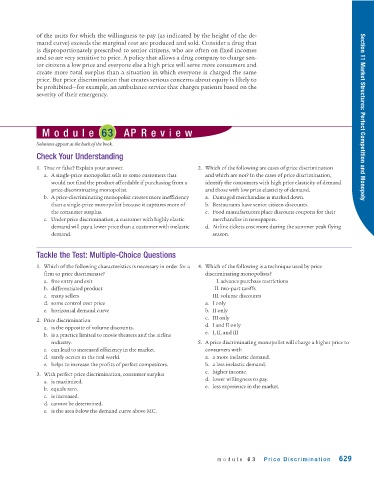Page 671 - Krugmans Economics for AP Text Book_Neat
P. 671
of the units for which the willingness to pay (as indicated by the height of the de-
mand curve) exceeds the marginal cost are produced and sold. Consider a drug that
is disproportionately prescribed to senior citizens, who are often on fixed incomes
and so are very sensitive to price. A policy that allows a drug company to charge sen-
ior citizens a low price and everyone else a high price will serve more consumers and
create more total surplus than a situation in which everyone is charged the same
price. But price discrimination that creates serious concerns about equity is likely to
be prohibited—for example, an ambulance service that charges patients based on the
severity of their emergency.
Module 63 AP Review Section 11 Market Structures: Perfect Competition and Monopoly
Solutions appear at the back of the book.
Check Your Understanding
1. True or false? Explain your answer. 2. Which of the following are cases of price discrimination
a. A single-price monopolist sells to some customers that and which are not? In the cases of price discrimination,
would not find the product affordable if purchasing from a identify the consumers with high price elasticity of demand
price-discriminating monopolist. and those with low price elasticity of demand.
b. A price-discriminating monopolist creates more inefficiency a. Damaged merchandise is marked down.
than a single-price monopolist because it captures more of b. Restaurants have senior citizen discounts.
the consumer surplus. c. Food manufacturers place discount coupons for their
c. Under price discrimination, a customer with highly elastic merchandise in newspapers.
demand will pay a lower price than a customer with inelastic d. Airline tickets cost more during the summer peak flying
demand. season.
Tackle the Test: Multiple-Choice Questions
1. Which of the following characteristics is necessary in order for a 4. Which of the following is a technique used by price
firm to price discriminate? discriminating monopolists?
a. free entry and exit I. advance purchase restrictions
b. differentiated product II. two-part tariffs
c. many sellers III. volume discounts
d. some control over price a. I only
e. horizontal demand curve b. II only
c. III only
2. Price discrimination
d. I and II only
a. is the opposite of volume discounts.
e. I, II, and III
b. is a practice limited to movie theaters and the airline
industry. 5. A price discriminating monopolist will charge a higher price to
c. can lead to increased efficiency in the market. consumers with
d. rarely occurs in the real world. a. a more inelastic demand.
e. helps to increase the profits of perfect competitors. b. a less inelastic demand.
c. higher income.
3. With perfect price discrimination, consumer surplus
d. lower willingness to pay.
a. is maximized.
e. less experience in the market.
b. equals zero.
c. is increased.
d. cannot be determined.
e. is the area below the demand curve above MC.
module 63 Price Discrimination 629

